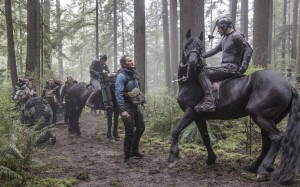
Among the seasonal entrants boasting convincing otherworldly visuals, is the latest installment in Fox’s rebooted Planet of the Apes series, Dawn of the Planet of Apes.
In this case, though, in the VFX department, Apes isn’t only competing with other summer tentpoles and genre offerings, but with its own legacy, particularly the breathtaking mo-cap work done by Andy Serkis as lead simian Ceasar, here joined by an even larger retinue of actors dawning “digital make-up,” (as Serkis calls it), to bring the apes further to life.
In this installment, the apes are threatened by a surviving human colony just south of the apes’ camp in Marin county in the remains of San Francisco.
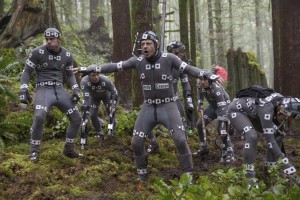 Dan Lemmon shares the visual effects supervisor title with Joe Letteri on the film, as each oversee numerous simultaneous Weta Digital projects at once, including the coming Batman/Superman film, and a slew of Avatar installments.
Dan Lemmon shares the visual effects supervisor title with Joe Letteri on the film, as each oversee numerous simultaneous Weta Digital projects at once, including the coming Batman/Superman film, and a slew of Avatar installments.
“People had somewhat low expectations of the first one,” he said of 2011’s surprising Rise of the Planet of the Apes, but once it established its own particular bar, “there was no way the second film could be a repeat of the first.”
So this one was looked at “with fresh eyes and expanded to a bigger cast of characters,” in particular simian ones.
We were recently able to catch up with husband-and-wife Ape writer/producers Rick Jaffa and Amanda Silver, who helped rekindle the franchise this time around, and now share writing credits with Mark Bomback, as they get busy on new installments of Jurassic Park and Avatar. They were able to take some time and give us an above-the-line perspective on their own “fresh eyes.”
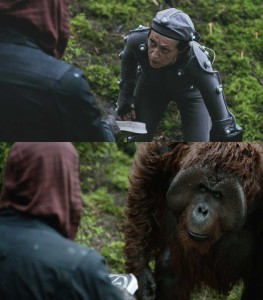 When they were rebooting the series, being “completely naive,” as they put it, about what might have been possible from a VFX standpoint, when creating the story, they knew they would “have to find an incredible actor,” so audiences would be “feeling Ceasar’s pain.”
When they were rebooting the series, being “completely naive,” as they put it, about what might have been possible from a VFX standpoint, when creating the story, they knew they would “have to find an incredible actor,” so audiences would be “feeling Ceasar’s pain.”
As Jaffa put it, “It’s Joe Letteri who’s the hero in our household,” said Jaffa, “He said, ‘you’ve got to get Andy Serkis!’”
“It’s incredible to see Andy’s performance,” Silver agreed, as they both tell of moments when the real, unrendered Serkis left people on the set in tears. After leaving his human family behind in the first film, and wounded and inquiring after the well-being of his ape family in this one, “The performance is still there,” she said.
But translating those performances and those half-finished sets into fully extended, rendered landscapes, falls back on the FX side.
Silver said Lemmon was “the eye of WETA” on the set, watching those performances “figuring out what they can do, analyzing it in his head” as the scenes unfold.
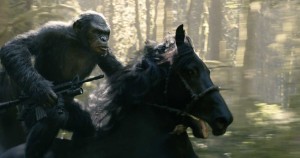 He was also working with a director new to the franchise, in Matt Reeves, and new actors essaying simian roles, including Toby Kebbell as the human-scarred Koba, and Nick Thurston as Ceasar’s son, Blue Eyes.
He was also working with a director new to the franchise, in Matt Reeves, and new actors essaying simian roles, including Toby Kebbell as the human-scarred Koba, and Nick Thurston as Ceasar’s son, Blue Eyes.
They join a retinue of returning ape thespians, including the theatrically-trained Karin Konoval, who plays wise old orangutan Maurice.
“We knew Andy was going to do a good job,” Lemmon continued, but now, with a repertory company of digitally-clad actors around him, “we had to make sure the equipment was going to capture the data” that would relay the increased subtlety of the work.
Equipment upgrades included “a lot more sophisticated facial rigs. Rise was a lot more forgiving,” he added, since it was “a lot more stagebound” than the sequel.
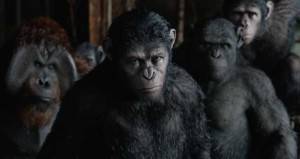 One of the big breakthroughs in that first film was being able to have the mo-cap actors on set, interacting with the rest of the cast, rather than being tethered to greenscreen-only environments. That was made possible by more portable equipment and lots of cables.
One of the big breakthroughs in that first film was being able to have the mo-cap actors on set, interacting with the rest of the cast, rather than being tethered to greenscreen-only environments. That was made possible by more portable equipment and lots of cables.
“One of the big things was getting rid of a lot of our cables,” said Lemmon, adding that while going wireless is taken for granted these days, “data had to be synchronized to the microsecond,” to capture all the movements the actors were making.
And being outdoors didn’t just make it harder in terms of figuring out how to keep mo-capped actors emoting in a scene. It created postproduction challenges, as well.
Lemmon explained that hair and fur rendering were also a challenge. “We had to get the fur to look realistic,” Lemmon said, meaning fur-in-rain with water droplets, clumped-up muddy fur, and more.
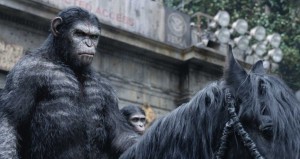 But it was all part of an ongoing process. Lemmon said that WETA’s mo-cap chops in general, and simian chops in particular, have been in a “constant state of iteration since King Kong.” He noted that there were no specific technological breakthroughs this time, it was more of a “craftsmanship thing,” in terms of data capture on set, and rendering in post.
But it was all part of an ongoing process. Lemmon said that WETA’s mo-cap chops in general, and simian chops in particular, have been in a “constant state of iteration since King Kong.” He noted that there were no specific technological breakthroughs this time, it was more of a “craftsmanship thing,” in terms of data capture on set, and rendering in post.
“It’s not only about creating a cool monster,” said Jaffa. “For us, those creatures are characters, with emotions and back stories. It’s more than a big black robot.”
Lemmon agreed, saying that for WETA, “it’s all about the script and the story. Our favorite thing is to collaborate. For us, the big thing is giving filmmakers and actors access to performance capture tools. That’s the real power of these films and technology.”





